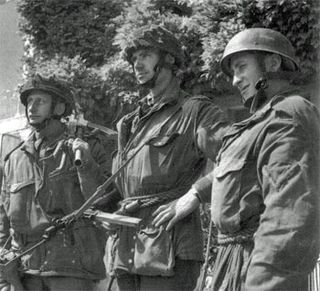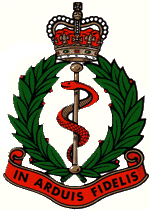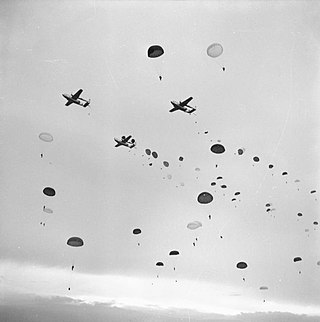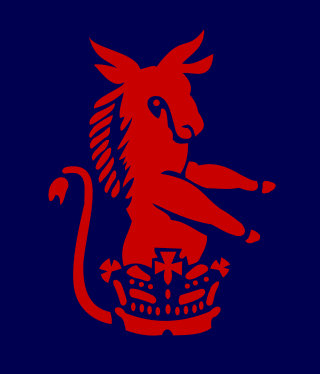
The 1st Airborne Division was an airborne infantry division of the British Army during the Second World War. The division was formed in late 1941 during the Second World War, after the British Prime Minister, Winston Churchill, demanded an airborne force, and was initially under command of Major-General Frederick A. M. "Boy" Browning. The division was one of two airborne divisions raised by the British Army during the war, with the other being the 6th Airborne Division, created in May 1943, using former units of the 1st Airborne Division.

The 6th Airborne Division was an airborne infantry division of the British Army during the Second World War. Despite its name, the 6th was actually the second of two airborne divisions raised by the British Army during the war, the other being the 1st Airborne Division. The 6th Airborne Division was formed in the Second World War, in mid-1943, and was commanded by Major-General Richard N. Gale. The division consisted of the 3rd and 5th Parachute Brigades along with the 6th Airlanding Brigade and supporting units.
This is a list of British ground forces in the Falklands War. For a list of ground forces from Argentina, see Argentine ground forces in the Falklands War
This is the complete order of battle of Allied and German forces involved during Operation Market Garden.

The 5th Infantry Brigade was a regular infantry brigade of the British Army that was in existence since before the First World War, except for a short break in the late 1970s. It was an Airborne Brigade from the early 1980s until amalgamating with 24th Airmobile Brigade, in 1999, to form 16 Air Assault Brigade.

The 5th Parachute Brigade was an airborne forces formation of brigade strength, raised by the British Army during the Second World War. Created during 1943, the brigade was assigned to the 6th Airborne Division, serving alongside the 3rd Parachute Brigade and the 6th Airlanding Brigade.

The 1st Parachute Brigade was an airborne forces brigade formed by the British Army during the Second World War. As its name indicates, the unit was the first parachute infantry brigade formation in the British Army.

The 2nd Parachute Brigade was an airborne forces brigade formed by the British Army during the Second World War.

The 3rd Parachute Brigade was an airborne forces brigade raised by the British Army during the Second World War. The brigade was initially part of the 1st Airborne Division, but remained in Britain when that division was sent overseas, and became part of the 6th Airborne Division, alongside 5th Parachute Brigade and 6th Airlanding Brigade.

The 6th Airlanding Brigade was an airborne infantry brigade of the British Army during the Second World War. Created during May 1943, the brigade was composed of three glider infantry battalions and supporting units, and was assigned to the 6th Airborne Division, alongside the 3rd and 5th Parachute Brigades.

On 15 August 1944, Allied forces carried out Operation Dragoon, a set of simultaneous amphibious landings by three US infantry divisions followed by four Free French divisions along the Mediterranean coast of France. The main landings were preceded by nighttime paratroop drops and commando beach landings. This was a phase of the European Theatre of World War II.
The Allied invasion of Italy, a phase of the Mediterranean Theater of World War II, took place on 3 September at Reggio di Calabria, and on 9 September 1943 at Taranto and Salerno. Allied naval forces landed American and Commonwealth troops on the beaches of southern Italy where they faced resistance from Axis forces.

The 195th (Airlanding) Field Ambulance was a Royal Army Medical Corps unit of the British airborne forces during the Second World War.

The 224th (Parachute) Field Ambulance was a Royal Army Medical Corps unit of the British airborne forces during the Second World War.

The 16th Airborne Division was an airborne infantry division of the British Territorial Army. It was first commanded by Major-General Roy Urquhart, and had its divisional headquarters in London.

The 31st Infantry Brigade was an infantry formation of the British Army, which participated in both the First and the Second World Wars. The brigade was later reformed after the end of the war serving in the British Army of the Rhine until the end of National Service in 1956, which saw the reorganisation of the brigade as the 11th Infantry Brigade.
The Northern Army Group (NORTHAG) was a NATO military formation comprising five Army Corps from five NATO member nations. During the Cold War NORTHAG was NATO's forward defence in the Northern half of the Federal Republic of Germany (FRG). The Southern half of the Federal Republic of Germany was to be defended by the four Army Corps of NATO's Central Army Group (CENTAG). During wartime NORTHAG would command four frontline corps and one reserve corps. Air support was provided by Second Allied Tactical Air Force.
The following is a hierarchical outline for the structure of the British Army in 1989. The most authoritative source for this type of information available is Ministry of Defence, Master Order of Battle, and United Kingdom Land Forces, HQ UKLF, UKLF ORBAT Review Action Plan, HQ UKLF, 1990.











